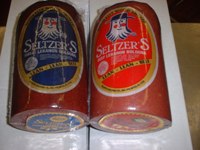
By Sam Gazdziak
Since Seltzer’s Smokehouse was founded in Palmyra, Pa., 1902, the company has seen many historic events — the Great Depression, two world wars, the birth of the civil rights and women’s rights movements, the Chicago Cubs winning a World Series — but the product that is made today is essentially the same thing that Harvey Seltzer created more than 100 years ago.
While the company is not the oldest maker of Lebanon bologna in the country, it still utilizes the same spice blend that Seltzer developed at the beginning, and it is the only company that still uses wooden smokehouses instead of the modern equivalent. The company is still run by the Seltzer family. When Harvey died in 1945, his son, Jack, took over the business. Jack, now retired, was also a long-time member of the Pennsylvania House of Representatives. Craig Seltzer, Jack’s son, now represents the third generation of leadership of Seltzer’s Smokehouse.
Lebanon bologna is a product native to the Pennsylvania Dutch area, though the company has consumers nationwide. Ron Fouché, who has been with the company for 52 years and held a variety of positions, explains the difference between bologna and boloney.
“It’s an all-beef, fermented and semi-dried sausage,” he says. “It’s about 90 percent fat-free, compared to regular boloney or a hot dog, which is between 20 and 30 percent fat.” The product also must be all skeletal meat. Due to the process, which reduces the meat’s pH to below 5, the finished product is smokier and tangier than boloney.
He notes that the product originally came from the native Pennsylvania Dutch who had cows that were too old to milk and too tough to process into steaks, so they processed the meat into bologna instead.
Seltzer’s has successfully adapted as processing technology has changed while staying true to the original process. Fouché says that the company first looked at starter cultures during the 1960s before it finally found a workable culture in the ’80s. It has kept its spice blend essentially the same, though it lost some ingredients due to the destruction of spice fields in World War II.
“I came here in 1957, and we make a far better product today that we ever did,” Fouché says. “It’s much more consistent.”
On average, Seltzer’s sells between 110,000 and 120,000 pounds of Lebanon bologna a week. Along with a traditional product, it also sells a sweet bologna and a double-smoked sweet bologna, which uses more sugar in its formulation, a “smoke and honey” variety, a Bombergers sweet bologna brand that is made with brown sugar, and a Baum’s old-fashioned sweet bologna. Baum’s was a company in Elizabethtown, Pa., that closed its operation in 1984 and asked Seltzer’s to make its product about three years ago. Seltzer’s also produces private-label products for a variety of customers.
The romance of the business
Seltzer’s is still located in the building in which it was founded in 1902, putting it right in the middle of Palmyra with not much space to expand. The company has built vertically to add more office space, and it has a company store located in a separate building a couple of blocks away. It also bought a former Swift plant in Lebanon in 1970 and converted it into a grinding facility.“We coarse-grind in Lebanon, add ingredients, mix it and bring it up [to Palmyra],” explains Fouché. It is then finely ground and stuffed into a variety of casings, from an 8-ounce unit to a 27-pound unit.
Most of what Seltzer’s does is very state-of-the art, from its coarse-grinding and blending operation in Lebanon to its slicing and packaging processes in Palmyra. The company’s smokehouses, however, are state-of-the-19th century technology wooden smokehouses. They represent, as Fouché says, the romance of the business.
There are 10 smokehouses outside the company’s headquarters, and each one is about 12-by-18-by-24 feet. Depending on the size of the product, a house can accommodate as much as 1,500 pieces of product. Products are separated by size, and sweet bologna is separated from the regular product. The smokehouses tend to last 13 to 18 years before they are torn down and rebuilt.
“How do you get stuff up to the top of the smokehouse? You throw it up by hand,” Fouché explains. “The guy at the bottom throws it up to the guy in the middle, and the guy in the middle throws it up to the guy at the top, and he hangs it on the rails.”
The process requires a great deal of coordination, as one botched throw or catch can result in a log of bologna splattering on the floor of the smokehouse. At the bottom of each house is a pit made of fire-lined brick that holds the slab wood that’s used in the smoking process.
“Hardwood is used for two primary purposes,” he explains. “It has a higher BTU, and you don’t get quite as much residue out of it.” The company does not use any fruitwoods, which would impart a different flavor profile.
Each house has six nozzles that spray three gallons an hour each into the area. A metal plate is placed on top of the pit and scattered with sawdust. When the fire starts to heat up the plate, the water sprayed from the nozzles produces the smoke.
As the smokehouses are all outside, the seasons affect the smoking process. Generally speaking, Fouché says, it takes anywhere from 36 to 42 hours for the product to be finished. In the winter months, when the temperatures and humidity are low, it may require as much as an extra 12 to 24 more hours to smoke the product.
“Mother Nature is our friend and our enemy sometimes,” Fouché explains. “Our critical control points in the HACCP program is a pH of 5 and under, a temperature of 120 degrees for a minimum of 68 minutes. If we hit those criteria, we have a safe product, but that does not mean that it’s finished. Our smokemasters are the ones that determine that.”
Seltzer’s five smokemasters are all employees who have come up through the ranks, and at least one of them is on the premises whenever product is being smoked. They monitor the products constantly, whether by visual inspection, pH testing or slicing, to determine when the bologna is ready.
“We’re what I call ‘the last of the Mohicans’ to still produce our product in old-fashioned wooden pit smokehouses,” Fouché says. He acknowledges that the stainless-steel smokehouses perform well, but the product is different in a couple of aspects.
“One, [product] doesn’t taste the same and two, [it doesn’t have] the holding qualities and slicing qualities that ours has,” he says. “Is ours superior? We think it is, but I guess we’re prejudiced."
A dirty job
The company’s adherence to tradition has brought it a fair share of attention. Before USDA and insurance regulations made it prohibitive, the company took thousands of guests on tours of the facility. More recently, the company was featured on “Dirty Jobs,” a popular Discovery Channel show where host Mike Rowe tackles labor-intensive, dirty and unglamorous jobs. Over the course of a day, Rowe came to Seltzer’s and cut fat and clots from the beef, loaded and unloaded a smokehouse, packaged bologna and cleaned out the ash from an empty house.Fouché admits that he wasn’t familiar with the show and was at first hesitant to be featured on a show called “Dirty Jobs,” which doesn’t seem to jibe with a clean meat-processing operation.
“Everything we have here is modern except when you get to the 1800s-style old-fashioned wood smokehouses,” he says. After some conversations with the company’s management and people on the show, the company agreed to the show. Rowe came with a small crew and spent a full day at the two plants, taking part in as many of the day-to-day operations as possible. His grandchildren, who are big fans of the show, were so excited that they came up to the plant to meet Rowe.
The show aired earlier this year and has become one of the more popular episodes. Following the episode’s premiere, Seltzer’s mail-order business took a sharp upswing.
“Within two hours of that airing, our Web site had more than 5,000 hits and there were a lot of orders that came in,” says Fouché. The unexpected increase in interest for Seltzer’s products almost overwhelmed the single employee responsible for the mail-order part of the business, and the company had to scramble to give her extra help.
“We can always tell when it airs, because we’ll always pick up 30 or 40 or even a couple hundred mail orders,” he adds.


